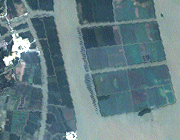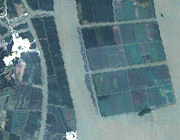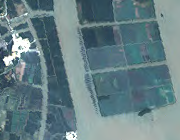The JPEG2000 file format was put forward as an improvement on the classic
JPEG format. In my experience, it is not. It does not come as a
surprise that support for the format, several years later, is almost
non-existent - there is not a single web browser, paint program, or office
app which supports it directly.
In fact, upon first testing, it appeared to be step backwards, producing
significantly more visual distortion at the same file sizes as classic JPEG.
Upon further testing, it appears to be roughly comparable. JPEG2000
producing a slightly different kind of distortion, characterized by
significant blurring.
Here are some examples so you can see the difference with LandSat
imagery. The JPEG2000 were compressed using the
LEAD Tools PhotoShop plugin. (I did some subsequent testing with
the JPEG2000 output of the OpenJPEG
library
which produced similar results.)
The JPEG were compressed with normal PhotoShop.
I started with a LandSat scene of the Pearl River delta in China,
compressed it with both codecs to 10% of original filesize, then studied the
results to find any noticeable difference from the original. Both
codecs did an excellent job, as most of the image was visually
indistinguishable. I found one small area in which differences are
easier to see:


